
BIX ARTICLE
The case for forever high interest rates
May 14, 2024
|
6 min read
Featured Posts
Social Bonds Illustrative Use-Of-Proceeds Case Studies Coronavirus
Jul 06, 2020
|
2 min read
Sustainable Banking Network (SBN) Creating Green Bond Markets
Jul 06, 2020
|
2 min read
Why is Inflation Making a Big Comeback After Being Absent for Decades in the U.S.?
Mar 24, 2022
|
7 min read
SC issues Corporate Governance Strategic Priorities 2021-2023
Mar 29, 2022
|
3 min read
May 13, 20244:45 PM GMT+8
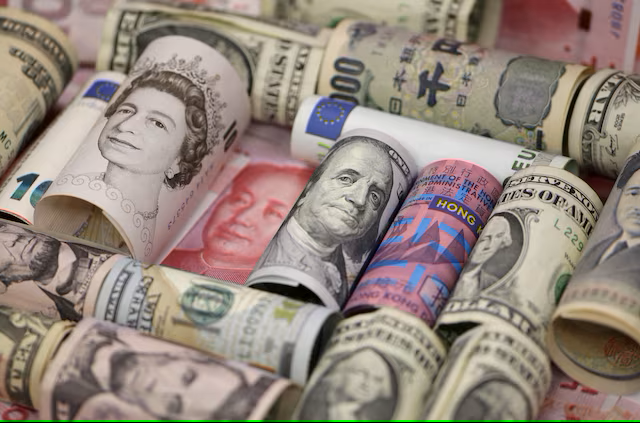
Euro, Hong Kong dollar, U.S. dollar, Japanese yen, British pound and Chinese 100-yuan banknotes are seen in a picture illustration shot January 21, 2016. To match Special Report CHINA-INVESTMENT/EUROFX REUTERS/Jason Lee/Illustration/File Photo Purchase Licensing Rights
May 13 (Reuters) - If financial markets are right, interest rates won't just stay high this year, but possibly forever.
The return of inflation means ultra-low rates are history. And markets now reflect a scenario where even the neutral interest rate that balances the economy in the long run after factoring in inflation, dubbed 'R-star', is rising, economists say.
Traders see U.S. rates at around 4% at the end of the decade, far higher than policymakers' 2.6% long-run expectations. Euro area rates are seen around 2.5%, above what has prevailed for most of the bloc's history.
Yet making the right call on where rates settle is a huge challenge for policymakers and investors -- many economists reckon R-star is lower than before the great financial crisis, but disagree on how to calculate it, its current level and whether it is rising.
BNY Mellon Investment Management's chief economist, Shamik Dhar, who reckons R-star has risen is "nervous that hasn't been fully priced into equity and property markets."
1/ FOOTING THE BILL
Huge investment needs, whether climate or military, and rising interest costs will keep government borrowing high.
Economists debate the impact of rising debt but some expect spending needs will drive rates up.
Advanced economy budget deficits at 5.6% of output in 2023 were nearly double 2019's 3% and will remain elevated at 3.6% in 2029, the IMF estimates.
Aviva Investors' head of rates Ed Hutchings said higher deficits would raise the premium investors demand to hold government bonds.
But productivity gains have slowed and potential growth is seen subdued on both sides of the Atlantic, factors economists reckon dampen investment.
"That would argue for less of an increase in neutral policy rates," said First Eagle Investment Management portfolio manager Idanna Appio, a former Fed economist.
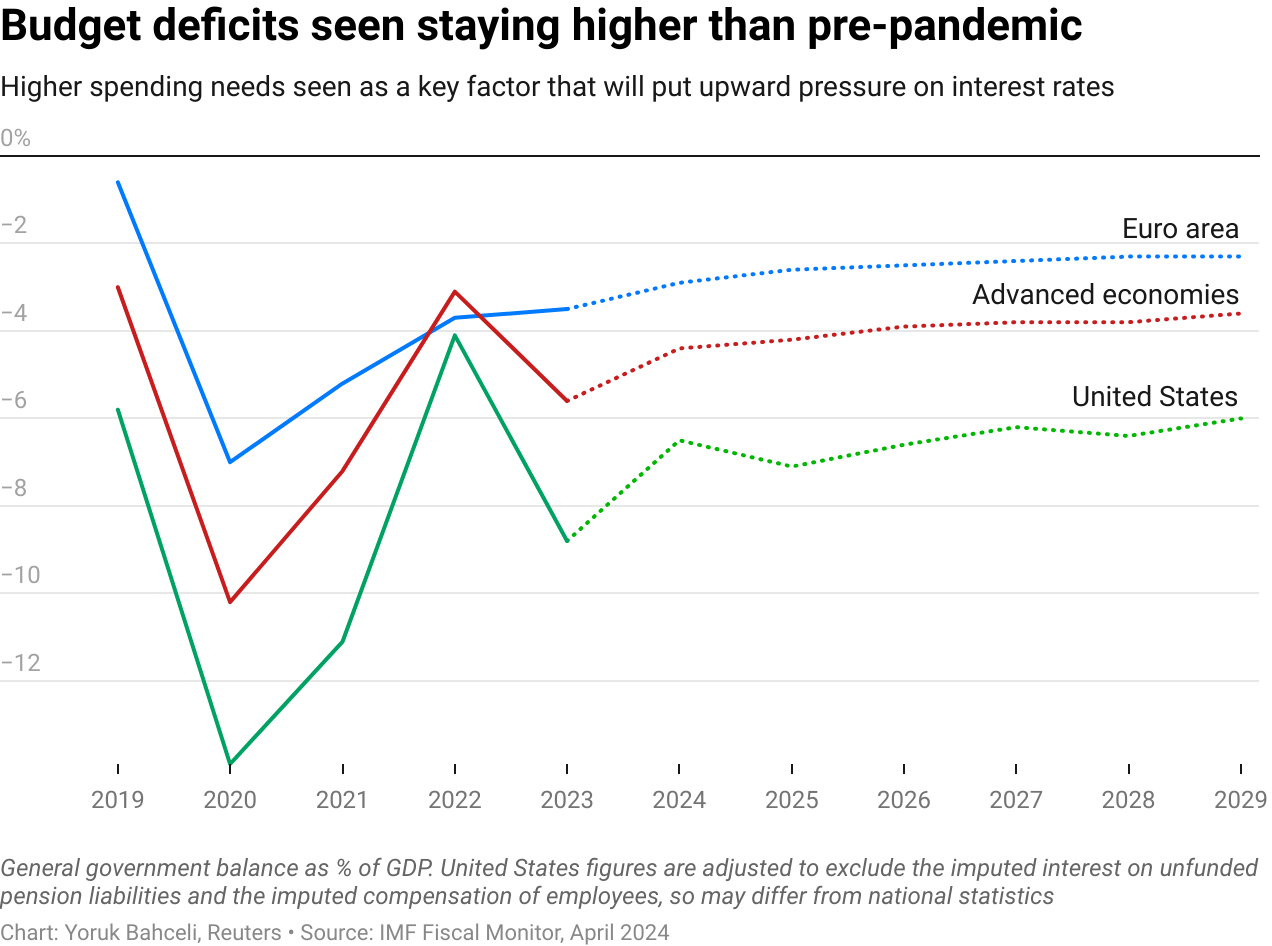
Reuters Graphics
2/ OLDER
Demographics is one of the biggest uncertainties facing longer-term rates, said BNY Mellon's Dhar, a former Bank of England economist.
There is consensus that a savings glut helped by pre-retirement hoarding in rich countries has depressed rates.
That may continue; 16% of the world population will be over 65 in 2050, from 10% in 2022, the United Nations projects. That will likely be most strongly felt in Europe.
But the ratio of dependents, including retirees, to workers is rising. That will cause rates to rise as age-related spending cuts saving, economists Charles Goodhart and Manoj Pradhan argue.
Plugging pension shortfalls through borrowing would also put upward pressure to rates, Nomura said.
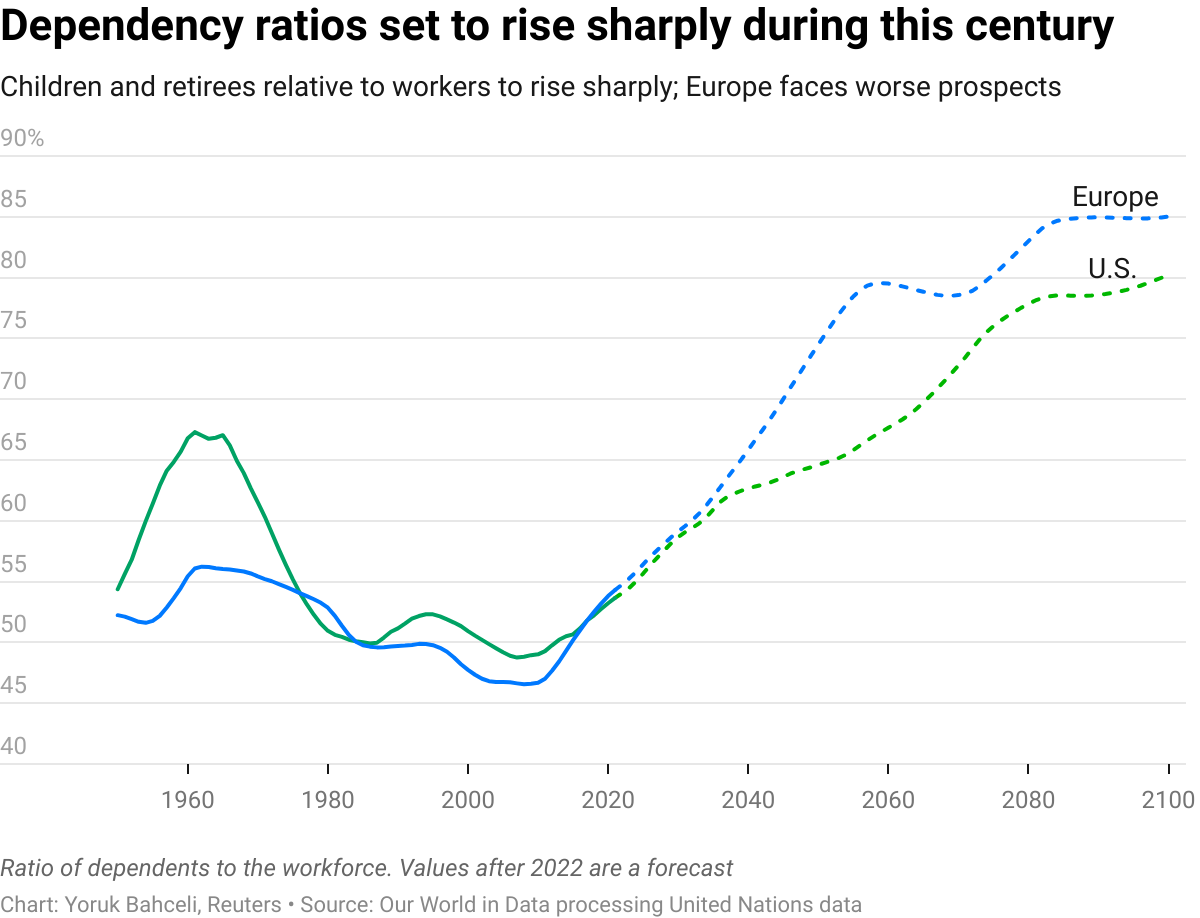
Reuters Graphics
3/ HEATING UP
Gauging the economic impact of climate change is another big challenge.
The green transition requires huge investment that could raise rates, says the European Central Bank's Isabel Schnabel, opens new tab, comparing the scale needed to rebuilding Europe after World War II.
The physical impacts of climate change also risk bouts of higher inflation, opens new tab and price volatility.
But they may shave as much as 17% off global output by 2050. The damage threatens productivity and could push R-star lower, an ECB paper, opens new tab argues.
Pricier clean energy may eventually reduce investment demand and therefore rates, the IMF says.
Soeren Radde, head of European economic research at hedge fund Point72, called the impact of climate change on rates a "big open debate".
"We've got negative shocks that essentially destroy demand. It's not clear that that will raise R-star," he said.
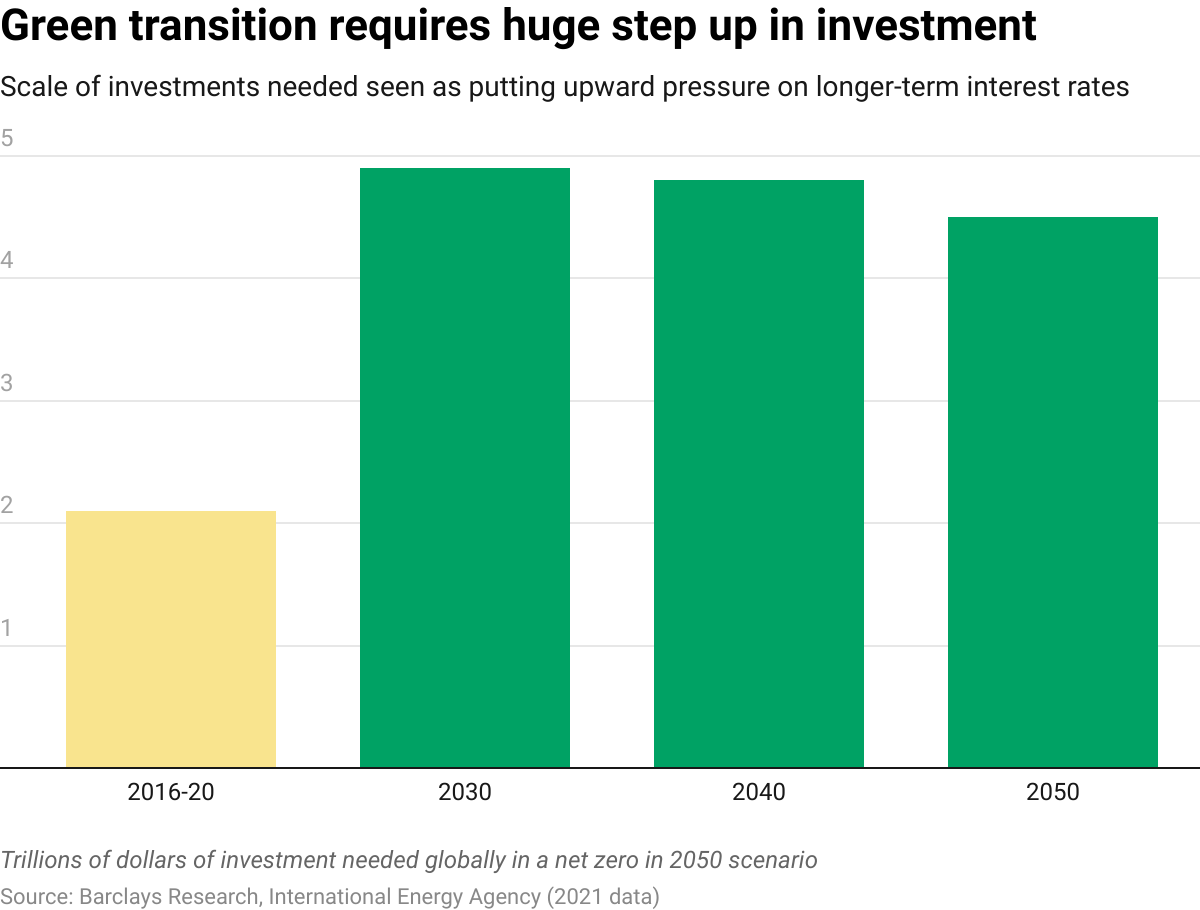
Reuters Graphics
4/ AI MANIA
How much the technological revolution can raise productivity and rates is hotly debated.
An AI-driven productivity boost may raise U.S. economic growth by 0.4 percentage points and by 0.3 points in other developed economies by 2034, Goldman Sachs expects. It sees upward pressure on rates, especially if AI adoption is frontloaded.
If the impact of AI is on par with electricity, growth will offset demographic pressures, Vanguard reckons. But it may disappoint if similar to computers and the internet.
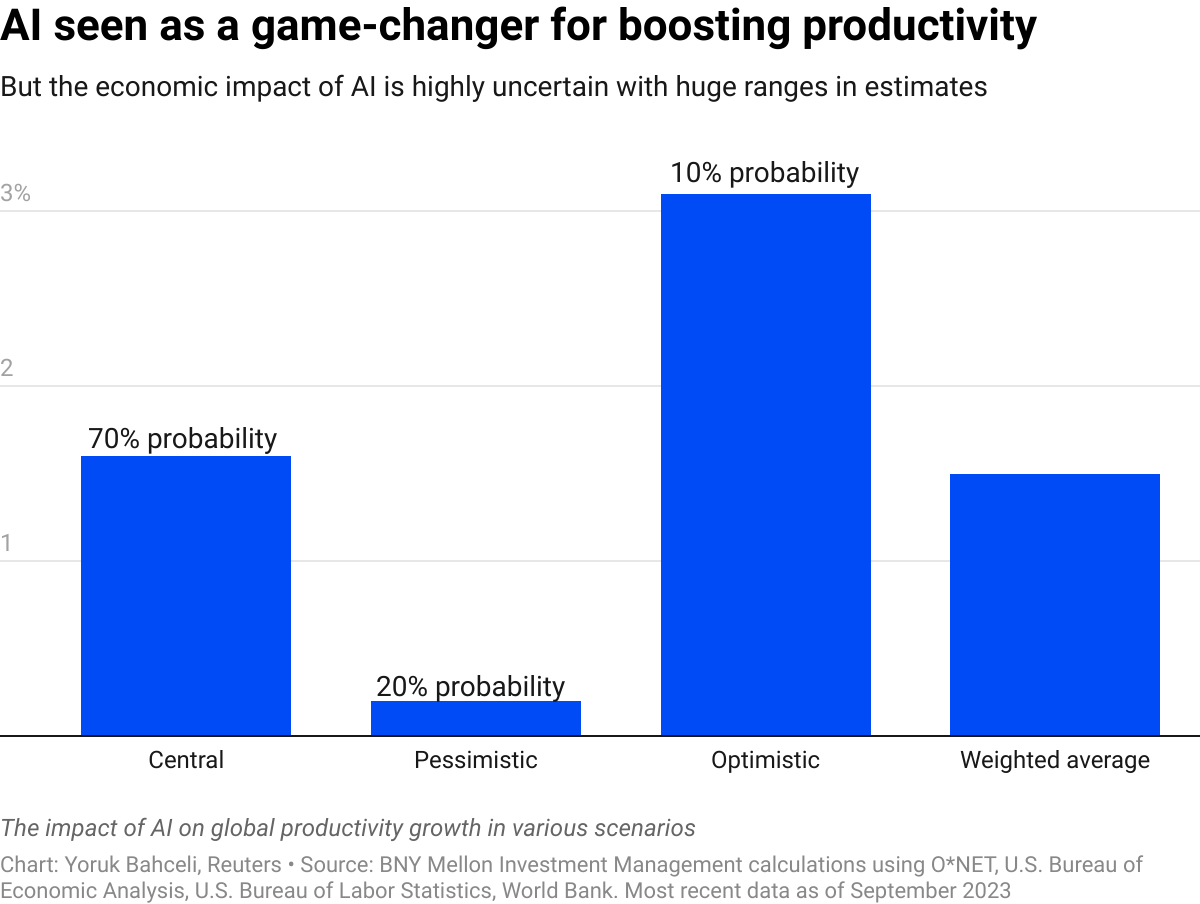
Reuters Graphics
5/ NEW REALITY
The COVID-19 pandemic, wars in Ukraine and Gaza and U.S.-China trade tensions point to higher supply-shock risks ahead.
"If central banks have to act against them... that can also on average lift the level of interest rates," Point72's Radde said.
Also risking higher rates is "friendshoring", whereby Western countries and companies seek to trade more with allies rather than China.
"Any of that is going to be, by nature of the fact that it is not the cheapest place to produce, more inflationary," said Columbia Threadneedle's global chief investment officer William Davies.
Mexico, for example, is now the biggest source of U.S. imports.
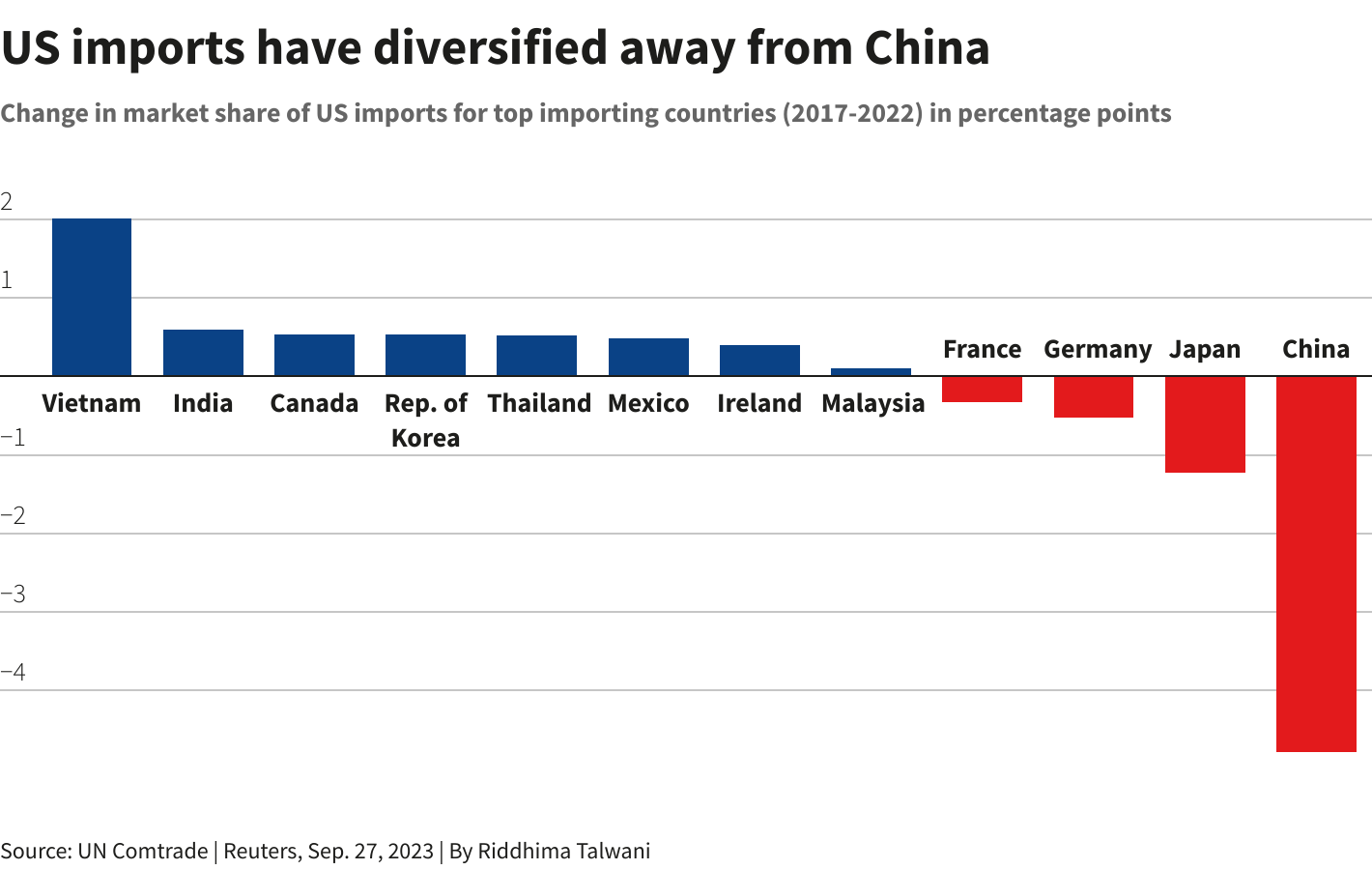
Reuters Graphics
(This story has been corrected to fix the quote attribution in paragraph 31)
Reporting by Yoruk Bahceli, additional reporting by Naomi Rovnick; editing by Gavin Jones, Dhara Ranasinghe and Christina Fincher
Source: Reuters
The information provided in this report is of a general nature and has been prepared for information purposes only. It is not intended to constitute research or as advice for any investor. The information in this report is not and should not be construed or considered as an offer, recommendation or solicitation for investments. Investors are advised to make their own independent evaluation of the information contained in this report, consider their own individual investment objectives, financial situation and particular needs and should seek appropriate personalised financial advice from a qualified professional to suit individual circumstances and risk profile.
The information contained in this report is prepared from data believed to be correct and reliable at the time of issuance of this report. While every effort is made to ensure the information is up-to-date and correct, Bond and Sukuk Information Platform Sdn Bhd (“the Company”) does not make any guarantee, representation or warranty, express or implied, as to the adequacy, accuracy, completeness, reliability or fairness of any such information contained in this report and accordingly, neither the Company nor any of its affiliates nor its related persons shall not be liable in any manner whatsoever for any consequences (including but not limited to any direct, indirect or consequential losses, loss of profits and damages) of any reliance thereon or usage thereof.
YOU MAY ALSO LIKE
ARTICLE
Aug 12, 2024
|
5 min read
ARTICLE
May 14, 2024
|
6 min read
ARTICLE
Oct 26, 2023
|
3 min read
ARTICLE
Sep 21, 2023
|
4 min read


